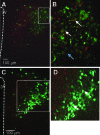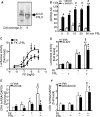Prolactin activates mitogen-activated protein kinase signaling and corticotropin releasing hormone transcription in rat hypothalamic neurons
- PMID: 19022892
- PMCID: PMC2659278
- DOI: 10.1210/en.2008-1023
Prolactin activates mitogen-activated protein kinase signaling and corticotropin releasing hormone transcription in rat hypothalamic neurons
Abstract
Prolactin (PRL) modulates maternal behavior and mediates hypothalamic pituitary adrenal axis inhibition during lactation via PRL receptors in the brain. To identify mechanisms mediating these effects, we examined the effects of PRL on signaling and CRH transcription in hypothalamic neurons in vivo and in vitro. Western blot of hypothalamic proteins from rats receiving intracerebroventricular PRL injection revealed increases in phosphorylation of the MAPK and ERK. Double-staining immunohistochemistry demonstrated phosphorylated ERK localization in parvocellular CRH neurons as well as magnocellular vasopressin and oxytocin neurons of the hypothalamic paraventricular (PVN) and supraoptic nuclei. PRL also induced ERK phosphorylation in vitro in the hypothalamic cell line, 4B, which expresses PRL receptors, and in primary hypothalamic neuronal cultures. Using reporter gene assays in 4B cells, or quantitative RT-PCR for primary transcript in hypothalamic cell cultures, PRL potentiated forskolin-stimulated CRH transcription through activation of the ERK/MAPK pathway. The effect of PRL in hypothalamic cell cultures was unaffected by tetrodotoxin, suggesting a direct effect on CRH neurons. The data show that PRL activates the ERK/MAPK pathway and facilitates CRH transcription in CRH neurons, suggesting that the inhibitory effect of PRL on hypothalamo-pituitary-adrenal axis activity reported in vivo is indirect and probably mediated through modulation of afferent pathways to the PVN. In addition, the prominent stimulatory action of PRL on the ERK/MAPK pathway in the hypothalamic PVN and supraoptic nucleus is likely to mediate neuroplasticity of the neuroendocrine system during lactation.
Figures





Similar articles
-
Prolactin induces Egr-1 gene expression in cultured hypothalamic cells and in the rat hypothalamus.Brain Res. 2009 Dec 11;1302:34-41. doi: 10.1016/j.brainres.2009.09.047. Epub 2009 Sep 18. Brain Res. 2009. PMID: 19769948 Free PMC article.
-
Central administration of glucagon-like peptide-1 activates hypothalamic neuroendocrine neurons in the rat.Endocrinology. 1997 Oct;138(10):4445-55. doi: 10.1210/endo.138.10.5270. Endocrinology. 1997. PMID: 9322962
-
Central administration of cocaine-amphetamine-regulated transcript activates hypothalamic neuroendocrine neurons in the rat.Endocrinology. 2000 Feb;141(2):794-801. doi: 10.1210/endo.141.2.7295. Endocrinology. 2000. PMID: 10650962
-
Studies on the neuroendocrine role of serotonin.Dan Med Bull. 2007 Nov;54(4):266-88. Dan Med Bull. 2007. PMID: 18208678 Review.
-
Regulation of gene expression in the hypothalamus: hybridization histochemical studies.Ciba Found Symp. 1992;168:127-38; discussion 138-43. Ciba Found Symp. 1992. PMID: 1425021 Review.
Cited by
-
Actions of Prolactin in the Brain: From Physiological Adaptations to Stress and Neurogenesis to Psychopathology.Front Endocrinol (Lausanne). 2016 Mar 30;7:25. doi: 10.3389/fendo.2016.00025. eCollection 2016. Front Endocrinol (Lausanne). 2016. PMID: 27065946 Free PMC article. Review.
-
Light-induced rapid Ca²⁺ response and MAPK phosphorylation in the cells heterologously expressing human OPN5.Sci Rep. 2014 Jun 19;4:5352. doi: 10.1038/srep05352. Sci Rep. 2014. PMID: 24941910 Free PMC article.
-
Prolactin regulation of oxytocin neurone activity in pregnancy and lactation.J Physiol. 2017 Jun 1;595(11):3591-3605. doi: 10.1113/JP273712. Epub 2017 Mar 23. J Physiol. 2017. PMID: 28211122 Free PMC article.
-
A Genetic Animal Model of Alcoholism for Screening Medications to Treat Addiction.Int Rev Neurobiol. 2016;126:179-261. doi: 10.1016/bs.irn.2016.02.017. Epub 2016 Mar 21. Int Rev Neurobiol. 2016. PMID: 27055615 Free PMC article. Review.
-
The brain as a source and a target of prolactin in mammals.Neural Regen Res. 2022 Aug;17(8):1695-1702. doi: 10.4103/1673-5374.332124. Neural Regen Res. 2022. PMID: 35017416 Free PMC article. Review.
References
-
- Mangurian LP, Walsh RJ, Posner BI 1992 Prolactin enhancement of its own uptake at the choroid plexus. Endocrinology 131:698–702 - PubMed
-
- Walsh R, Slaby F, Posner B 1987 A receptor-mediated mechanism for the transport of prolactin from blood to cerebrospinal fluid. Endocrinology 120:1846–1850 - PubMed
-
- Ben-Jonathan N, Mershon JL, Allen DL, Steinmetz RW 1996 Extrapituitary prolactin: distribution, regulation, functions, and clinical aspects. Endocr Rev 17:639–669 - PubMed
-
- Clapp C, Torner L, Gutierrez-Ospina G, Alcantara E, Lopez-Gomez F, Nagano M, Kellly P, Mejia S, Ma M, Martinez de la Escalera G 1994 The prolactin gene is expressed in the hypothalamic-neurohypophyseal system and the protein is processed into a 14-kDa fragment with activity like 16-kDa prolactin. Proc Natl Acad Sci USA 91:10384–10388 - PMC - PubMed
-
- Emanuele N, Jurgens J, Halloran M, Tentler J, Lawrence A, Kelley M 1992 The rat prolactin gene is expressed in brain tissue: detection of normal and alternatively spliced prolactin messenger RNA. Mol Endocrinol 6:35–42 - PubMed
Publication types
MeSH terms
Substances
Grants and funding
LinkOut - more resources
Full Text Sources
Miscellaneous

